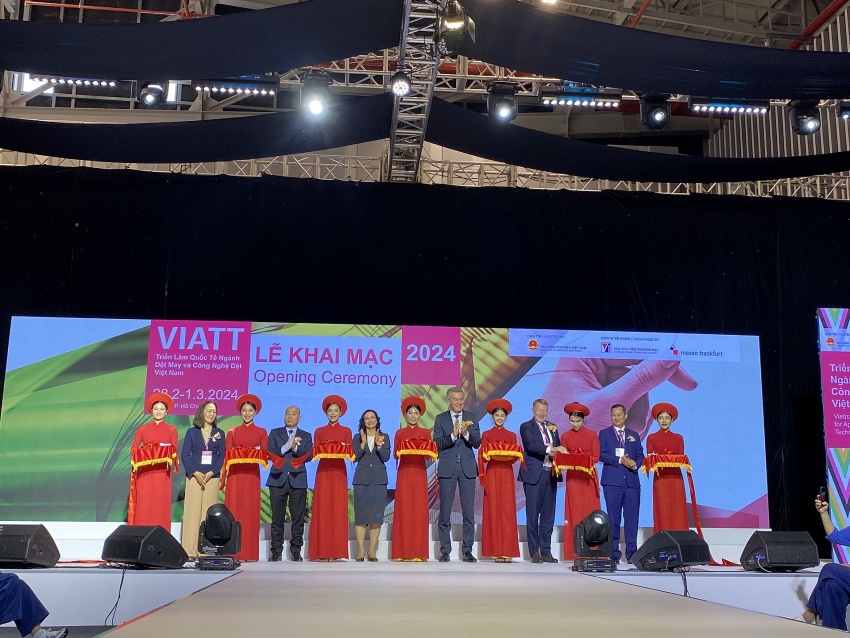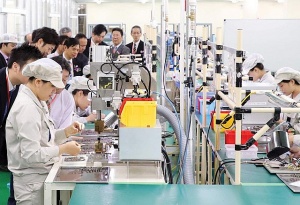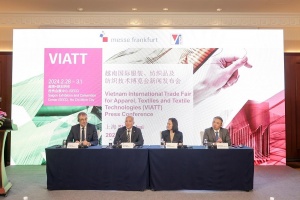Vietnam International Textile and Garment Industry Exhibition attracts more than 500 tenants
More than 500 domestic and foreign enterprises are participating in the Vietnam International Textile and Garment Industry Exhibition (VIATT 2024) taking place from February 28 to March 1 at the Saigon Exhibition and Convention Centre in Ho Chi Minh City.
The exhibition is focusing on specialised fields including fibres, fabrics and textile accessories, textiles, textile technology and sewing machines. It is being chaired by the Ministry of Industry and Trade and organised by the Department of Trade Promotion in partnership with Messe Frankfurt Group from Germany.
 |
VIATT 2024 has over 500 booths being run by more than 500 domestic and international businesses from 16 countries and territories, such as the United Kingdom, Germany, Bulgaria, Italy, the United States, Switzerland, Japan, Korea, Hong Kong, Taiwan, Thailand, Indonesia, India, Pakistan and China.
In her opening speech, Deputy Minister of Industry and Trade Phan Thi Thang assessed that in recent years, Vietnam's textile and garment industry has developed strongly and plays an increasingly important role in the growth of the economy.
| “Among all current industrial export products, textiles and garments have the highest export turnover and growth rate, accounting for 12-16 per cent of the country's total export turnover.” |
According to Thang, Vietnam's textile and garment export turnover has increased nearly 6 times since it became a member of the World Trade Organisation 15 years ago.
In addition, the textile industry currently employs more than two million workers, accounting for more than 10 per cent of the country's industrial workforce.
Statistics show that in 2023, textile and garment exports reached $40.3 billion, down 9.2 per cent compared to 2022.
The highlight of the textile and garment industry last year was the expanding efforts to new markets. In addition to traditional markets such as the US, Japan, Korea, and the EU, Vietnam exported a significant amount of textiles and garments to Canada, China, the UK, Australia, Russia, Indonesia, Thailand, Hong Kong and India.
As of February 15, Vietnam's textile and garment export turnover had reached $4.9 billion, an increase of 17 per cent over the same period last year.
“The textile and garment industry expects to achieve export turnover of $44 billion in 2024, an increase of 9 per cent compared to 2023,” Thang said.
To help textile and garment enterprises find new customers and markets, the Ministry of Industry and Trade is coordinating with industry associations to build a sustainable development plan that includes leather and footwear.
“Policies will also be proposed to help textile and garment enterprises convert production to a green and sustainable model,” she added.
Held for the first time, VIATT 2024 had created better conditions for businesses in the textile and garment sector in Vietnam to form trade connections with international businesses and participate in the global production chain, forming links from raw material production to final products.
At the same time, major brands from around the world are being encouraged to transfer technology, management experience and participate in the process of developing raw materials and auxiliary materials to form a domestic supply chain.
The textile and garment industry will also have access to modern and advanced technology from the EU, as well as investment and support projects to promote green production transformation, helping Vietnamese goods meet EU standards.
Currently, Vietnam is the world's third largest exporter of textiles and garments with much potential for further development.
Many international textile manufacturers have been expanding their operations in Vietnam to boost the already strong domestic industry. Being a member of international trade agreements such as the Regional Comprehensive Economic Partnership, the Comprehensive and Progressive Agreement for Trans-Pacific Partnership and the EU-Vietnam Free Trade Agreement will continue to support the development of the country's textile industry.
 | Japanese textile enterprises consider shrinking production in Vietnam Facing labour cost increases and a low localisation rate, some Japanese textile companies are thinking about cutting production in Vietnam. |
 | Vietnam's garment and textile companies eye sustainable products Companies seek to diversify supply chains to tap into opportunities from a wide range of new-generation free trade agreements and an increasing flow of investments into the local market. |
 | Textile and garment industry awaiting fresh drive in order to reverse fortunes Despite its continued reliance on traditional markets, the garments and textiles industry in Vietnam is gaining momentum for a gradual recovery in 2024 due to the diversification of its consumer base, products, and markets. |
What the stars mean:
★ Poor ★ ★ Promising ★★★ Good ★★★★ Very good ★★★★★ Exceptional
Related Contents
Latest News
More News
- Climate Finance Accelerator Vietnam begins search for projects seeking investment (December 18, 2025 | 17:22)
- Vietnam and Switzerland conclude SwissTrade (December 17, 2025 | 18:22)
- TECHFEST Vietnam 2025 links startups with policy and capital (December 15, 2025 | 18:21)
- MST to allocate $3.8 billion for sci-tech in 2026 (December 15, 2025 | 18:10)
- Long Thanh International Airport welcomes first Vietnam Airlines test flight (December 15, 2025 | 18:01)
- Health Innovation Hub: accelerating health equity through digital healthcare innovation (December 15, 2025 | 08:00)
- Vietnam’s first AI Law to take effect from March 2026 (December 12, 2025 | 09:00)
- Chi Communications joins SEA CAN alliance (December 11, 2025 | 17:39)
- New Law on High Technology sets incentives and safeguards (December 11, 2025 | 09:00)
- IBTE 2025 to return to Ho Chi Minh City this December (December 11, 2025 | 09:00)

 Tag:
Tag:





















 Mobile Version
Mobile Version